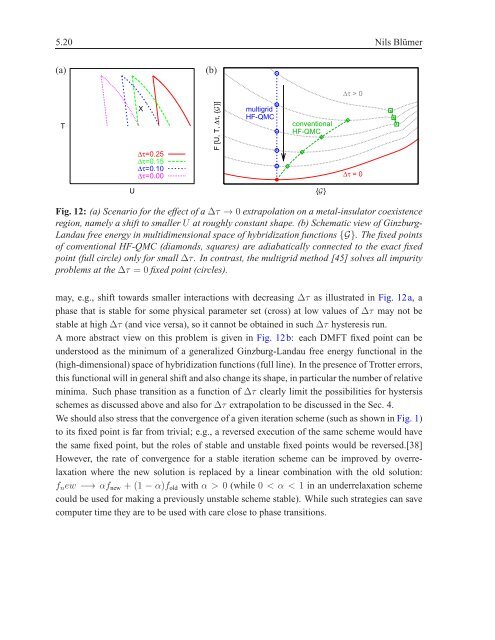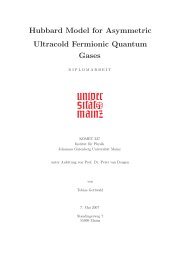5 Hirsch-Fye quantum Monte Carlo method for ... - komet 337
5 Hirsch-Fye quantum Monte Carlo method for ... - komet 337
5 Hirsch-Fye quantum Monte Carlo method for ... - komet 337
Create successful ePaper yourself
Turn your PDF publications into a flip-book with our unique Google optimized e-Paper software.
5.20 Nils Blümer<br />
(a) (b)<br />
T<br />
U<br />
X<br />
∆τ=0.25<br />
∆τ=0.15<br />
∆τ=0.10<br />
∆τ=0.00<br />
F [U, T, ∆τ, {G }]<br />
multigrid<br />
HF-QMC<br />
conventional<br />
HF-QMC<br />
{G }<br />
∆τ > 0<br />
∆τ = 0<br />
Fig. 12: (a) Scenario <strong>for</strong> the effect of a∆τ → 0 extrapolation on a metal-insulator coexistence<br />
region, namely a shift to smallerU at roughly constant shape. (b) Schematic view of Ginzburg-<br />
Landau free energy in multidimensional space of hybridization functions{G}. The fixed points<br />
of conventional HF-QMC (diamonds, squares) are adiabatically connected to the exact fixed<br />
point (full circle) only <strong>for</strong> small ∆τ. In contrast, the multigrid <strong>method</strong> [45] solves all impurity<br />
problems at the∆τ = 0 fixed point (circles).<br />
may, e.g., shift towards smaller interactions with decreasing ∆τ as illustrated in Fig. 12a, a<br />
phase that is stable <strong>for</strong> some physical parameter set (cross) at low values of ∆τ may not be<br />
stable at high∆τ (and vice versa), so it cannot be obtained in such ∆τ hysteresis run.<br />
A more abstract view on this problem is given in Fig. 12b: each DMFT fixed point can be<br />
understood as the minimum of a generalized Ginzburg-Landau free energy functional in the<br />
(high-dimensional) space of hybridization functions (full line). In the presence of Trotter errors,<br />
this functional will in general shift and also change its shape, in particular the number of relative<br />
minima. Such phase transition as a function of ∆τ clearly limit the possibilities <strong>for</strong> hystersis<br />
schemes as discussed above and also <strong>for</strong>∆τ extrapolation to be discussed in the Sec. 4.<br />
We should also stress that the convergence of a given iteration scheme (such as shown in Fig. 1)<br />
to its fixed point is far from trivial; e.g., a reversed execution of the same scheme would have<br />
the same fixed point, but the roles of stable and unstable fixed points would be reversed.[38]<br />
However, the rate of convergence <strong>for</strong> a stable iteration scheme can be improved by overrelaxation<br />
where the new solution is replaced by a linear combination with the old solution:<br />
fnew −→ αfnew + (1 − α)fold with α > 0 (while 0 < α < 1 in an underrelaxation scheme<br />
could be used <strong>for</strong> making a previously unstable scheme stable). While such strategies can save<br />
computer time they are to be used with care close to phase transitions.













